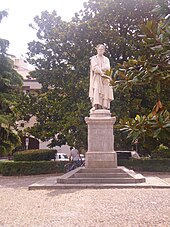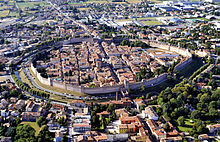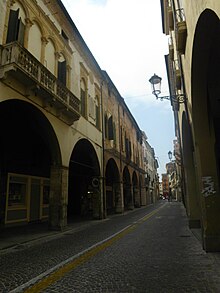 | ||
| Padua | ||
| region | Veneto | |
|---|---|---|
| Residents | 210.440 (2018) | |
| height | 12 m | |
| Tourist info web | www.turismopadova.it | |
| no tourist info on Wikidata: | ||
| location | ||
| ||
The town Padova (German: Padua) is in the region Veneto North of Italy.
background
| Distances | |
| Venice | 48 km |
|---|---|
| Vicenza | 44 km |
| Bassano del Grappa | 48 km |
| Abano Terme | 12 km |
| Montegrotto Terme | 16 km |
| Mestre | 42 km |
| Rovigo | 48 km |
Strolling through one of the oldest cities in Italy is particularly recommended because of the many magnificent buildings in the wonderful old town of the provincial metropolis.
getting there
By plane
The nearest airports are in Venice (VCE; approx. 40 km northeast), Treviso (TSF; 50 km northeast) and Verona (VRN; 95 km west). From Venice airport you can take the bus to Mestre, then the train to Padua (takes about 40 minutes in total).
By train
The 30-minute train ride from Padua to Venice or vice versa is just as cheap (4.10 euros per trip) as it is convenient. Many tourists use this for excursions and sightseeing 1 Central Station is located on the Milan – Venice railway line. The high-speed trains also stop in Padua Frecciarossa and Italo from Turin – Milan or Salerno – Naples – Rome. The journey from Milan takes less than two hours and costs 40 €, from Rome 3:20 hours for 80 € (normal price with FS, saver prices cheaper; with Italo 45 €).
From Vienna – Klagenfurt or Munich – Salzburg, Padua can be reached with the ÖBB Nightjet (night train; travel time from Munich 9½ hours, from Vienna 10:15 hours; tickets from € 49).
By bus
There are at least two stops for long-distance bus traffic. International lines bring travelers from Spain, Germany, Poland, Hungary, Romania, Croatia and countries in between. Padua is also a hub for domestic traffic, with connections to Turin and Genoa in the west and Sicily and Bari in the south.
- 2 Piazzale Boschetti bus station, Parcheggio Piazzale Boschetti, 35131 Padova.
- 3 Viale della Pace bus station, Viale della Pace, 35131 Padova.
In the street
Padua is on the ![]() A4 between Verona and Mestre, from Padua the
A4 between Verona and Mestre, from Padua the ![]() A13 south towards Bologna. Motorways are usually subject to tolls for cars.
A13 south towards Bologna. Motorways are usually subject to tolls for cars.
By boat
Since Padua is not far from the seaside city of Venice, the ship and ferry connections there are relevant.
mobility

Padua is also a typical one Bicycle city, because the Paduan loves and uses the bike! The many bicycles (secured by mighty locks, the black market with stolen bicycles is booming) are an integral part of the cityscape. In many cases it is students who cycle to their faculties - Padua has one of the oldest universities in the world.
Padua has a well organized Bus system (APS). The main transfer option between many of the lines is on the local one Central Station. In the city center, there are also two “minibuses” that can be used even in the narrow streets of the old town. So they represent an inexpensive alternative (bus ticket: 90 min = 1 euro) to get to know Padua's city center in the shortest possible time.
A disadvantage is that many lines are not available on Sundays and often only run until 10 p.m. in the evening.
Bus timetables are available from the tourist offices (e.g. at the train station or - in summer - at the basilica).
Operates in Padua since 2007 il tram, track-guided trolleybus, (quasi an intersection of bus and tram, so a so-called Translohr). However, the route network is still limited; an expansion to four lines is not planned for the next few years. - Il tram can be used with a bus ticket.
Park
Finding a parking space individually in the old town is not advisable, as almost all streets there are parking license areas. It is even more dangerous to drive through residential streets, even accidentally, to which attention is only drawn with small, overlookable signs. These streets are mostly monitored by cameras. The penalties are draconian and will be sent by post in German.
- 4 Padova Prato Parking, Via Giosuè Carducci, 1, 35123 Padova PD, Italy (directly opposite Prato della Valle). Tel.: 39 049 87520. In addition to numerous other car parks in Padua, this is the ideal car park for exploring the old town. It is located on the Prato della Valle on the outskirts of the old town and is only a 7-minute walk from the Antonius Church and the Orto Botanico and approx. 15 minutes from the Palazzo della Raggione. Access is via license plate recognition, which must be entered when paying for the exclusively available machines. Sensitive technology, which can lead to long queues alternately when entering or when paying, but there is still no alternative to parking space.Open: 24 hours a day.Price: depends on the hours, but inexpensive.
Tourist Attractions


Padua is a city steeped in history and therefore full of historical sights, which means that every art lover in Padua will get their money's worth.
Churches
- 1 Basilica di Sant'AntonioBasilica di Sant'Antonio - the basilica of St. Anthony with his tomb and the high altar with bronze statues by the late Gothic sculptor Donatello represents the architectural highlight of Padua.
- 2 Abbazia di Santa Giustina
Also:
- 3 Cappella degli Scrovegni - in terms of art history, mainly because of the wonderful cycle of frescoes by Giotto extremely important;
- 4 Basilica cattedrale di Santa Maria Assunta - despite the cooperation of Michelangelo rather unspectacular cathedral, but with a beautiful baptistery (baptistery);
- 5 Chiesa degli Eremitani (Hermit Church), which was badly destroyed in World War II; the frescoes destroyed in the process could only be partially restored;

Castles, chateaus and palaces
- 6 Palazzo della Ragione

The palace, built at the beginning of the 13th century, is the unofficial landmark of Padua. The upstairs council and courtroom - one of the largest halls in Europe - is extremely impressive. The wall frescoes from the 14th century are dedicated to astrological themes. There is also a large wooden horse (15th century) that was used at street festivals. Today the hall is used for changing exhibitions. On the ground floor of the Palazzo there are numerous delicatessen shops with exquisite regional specialties. From milk butcher to cheese, nuts, a variety of poultry and sausages to baccala, everything can be found there and the various scents inspire. Between them there is one or the other small bar for a prosecco break.
Buildings

- 7 Palazzo del Bò - Old University and Medical Lecture Hall
- 8 Caffè Pedrocchi - Formerly a meeting place for intellectuals, the café with its own flair is now one of the city's indispensable attractions
- 9 La SpecolaObservatory
- 10 Palazzo del Capitano with the Torre dell'Orologio (clock tower)
Monuments

- Statue of the poet Francesco Petrarch
- 11 Tomba di Antenore - the tomb of the alleged ancient city founder Antenor
Museums
- 12 Musei Civici Eremitani, Piazza Eremitani, 8 - Padova. Tel.: 39 049 820 45 21, Fax: 39 049 820 45 66, Email: [email protected]. The municipal hermit museum in the beautiful cloister of the neighboring hermit church turns out to be an archaeological museum (exhibits from the Roman times of Padua).
- Butterfly Arc. The Butterfly House was established in 1988 as the first living butterfly exhibition in Italy.
Streets and squares

- 14 Prato della Valle - the one after Red Square (Moscow) and the Place de la Concorde (Paris) third largest square in Europe;
- Piazza delle Erbe. In the place where the Palazzo della Ragione the big weekly market (see below) takes place.
Parks
- 15 Orto Botanico - The Botanical Garden, founded in the middle of the 16th century, which has been on the UNESCO World Heritage List since 1997, was already visited by Goethe for study purposes; since 2014 the Orto Botanico has been expanded to include the Giardino della Biodiversità. In addition to the historical impression of the old garden, a journey through the flora of the continents was created in modern halls, which is supplemented by excellently prepared didactic visual material. An exhibition area is integrated with changing art exhibitions on the topic. The combination of the historical botanical garden and the most modern processed botany is unique and absolutely worth seeing. The entrance is through the old botanical garden.
various
activities
shop
Like many Italian cities, Padua soon turns out to be a true shopping paradise.
- Fashion - the extremely lavish range of products on offer ranges from brand designer shops to typical Italian clothes shops:
- Markets - are held daily on different squares and road widenings in the city center as fruit and vegetable and / or mixed markets;
- Big market - Saturdays on Prato della Valle (We recommend); the market with an indescribable flair and a breathtaking variety of goods: flowers, clothing, housewares, baskets, shoes, bags and, for some years now, as competition to the large market on Saturdays with an excellent vegetable and fruit market for seasonal and regional products. These are usually cheaper in price than on the large market in front of the Palazzo delle Raggione.
- university. Founded in 1222, Padua's University is one of the oldest universities in the world. This is one of the reasons why it is not only one of the top attractions, but also has its own souvenir shop.
kitchen
Aperol was invented in Padua. The aperitif was developed by the brothers Silvio and Luigi Barbieri in 1919 exclusively for the international fair in Padua.

Under the Palazzo della Ragione is the Paduan Delicatessen Street! Essential for lovers of Italian delicacies! (Danger: Here, as in most supermarkets and shops, the siesta is held between 1 p.m. and 3 p.m.!
Cheap
- 1 Bar dei Osei, Piazza Dei Frutti 1. Tel.: 39 049 875 9606.Sandwich bar with a large selection.
- 2 La Folperia, Piazza Della Frutta, 35100 Padova PD. Stand up snack with seafood and fish. A must for every fish lover.Open: daily 5:00 p.m. - 9:00 p.m.Price: dishes from € 4.
medium
- 3 Pizeria Mandrillo, Via Santa Lucia, 59. Tel.: 39 049 876 5857. Pizzeria with very fast service and a large selection of pizzas.
Upscale
- 4 Ristorante Isola di Caprera, Via Marsilio da Padova, 11, 35139 Padova. Tel.: 39 049 876 0244. Traditional restaurant in the arcades not far from Piazza Delle with a large selection of typical meat and fish dishes.Open: daily 12:00 p.m. - 3:00 p.m. and 7:30 p.m. - 11:00 p.m., Sunday evening only for groups by appointment.Price: meat 25 € and fish menu 40 €.
nightlife
accommodation

Cheap
- 1 Ostello Città di Padova, Via Aleardo Aleardi 30. Tel.: 39 049 8752219.
medium
2 stars
- 2 Hotel Belludi 37, Via Luca Belludi 37. Tel.: 39 049 665633, Fax: 39 049 658685.
- 3 Hotel Casa del Pellegrino, Via M. Cesarotti 21. Tel.: 39 049 8239711, Fax: 39 049 8239780.
3 stars
- 4 Hotel Al Santo, Via del Santo 147. Tel.: 39 049 8752131, Fax: 39 049 8788076.
- 5 Albergo Verdi, Via Dondi dall'Orologio 7. Tel.: 39 049 8364163, Fax: 39 049 8780175.
- 6 Hotel Corso, Corso del Popolo 2. Tel.: 39 049 8750822, Fax: 39 049 661576.
- 7 Hotel Sant'Antonio, Via San Fermo 118. Tel.: 39 049 8751393, Fax: 39 049 8752508.
Upscale
4 stars
- 8 Hotel Donatello, Via del Santo 102/104. Tel.: 39 049 8750634, Fax: 39 049 8750829.
- 9 Hotel Plaza, Corso Milano 40. Tel.: 39 049 656822, Fax: 39 049 661117.
- 10 Methis Hotel, Riviera Paleocapa 70. Tel.: 39 049 8725555, Fax: 39 049 8725135.
- 11 Hotel Majestic Toscanelli, Via dell'Arco 2. Tel.: 39 049 663244, Fax: 39 049 8760025.
Learn

Work
security
Padua is also not noticeable for its abnormal crime rate, but, as everywhere, especially in the tourist conurbations, particular caution should be exercised, especially against pickpockets. In the city center, in particular, there is an increased number of pickpockets who keep approaching each other with begging tricks. The police also warn against buying counterfeit goods on the black market.
.jpg/220px-San_Canziano_(Padua).jpg)
health
Practical advice
Where do I buy my bus ticket? These are available in the so-called tabaccherias (tobacco shops) marked with a T and at the APS main counter at the train station.
Where are the tourist offices located?
- Downtown: Behind the Caffe Pedrocchi
- Right at the train station.
- In the summer opposite the Basilica of St. San Antonio. Free information, the PaduaCard and other products and brochures are available there. A city map of Padua city center is also available there for free to take away!
What is a PaduaCard? This is a tourist card, as is common in many cities, with which you can buy certain discounts. The PaduaCard includes free admission to twelve and reduced admission to twenty-six attractions; Furthermore, free use of public urban transport, free parking in selected parking spaces, discounts on bicycle rental prices, etc. The card is available for 48 hours at € 15 and for 72 hours at € 20 (as of December 2013) in the information offices mentioned or can be ordered over the Internet.
except Italian? In the tourist centers (outside of these, however, less so) one gets along well with English, and here and there also with German.
trips

- Colli Euganei. Euganean Hills. The protected hilly landscape of volcanic origin begins about 13 km southwest of Padua at the health resorts Abano Terme and Montegrotto Terme; There are numerous charming villas and wineries in the hills. Montegrotto Terme can be reached by train (hourly regional express towards Bologna) in 10 minutes. However, it is more comfortable to travel by car (the villas and wineries are hardly accessible by public transport). Those who are sporty can also bike from Padua to the Colli drive (Veneto circular route I2), but there are considerable inclines and declines.
- Villa Foscari, in Mira. One of the most famous villas designed by the Renaissance master builder Andrea Palladio, on the Brenta Canal (between Padua and Venice), approx. 30 km east, on the Veneto cycle route I1.

- Cittadella. Medieval city surrounded by a well-preserved city wall; 30 km north, 45 minutes by regional train (every hour).
- Estonian. Baroque cathedral, fort, Villa Contarini and archaeological museum; 32 km southwest (on the southern edge of the Colli Euganei).
- Vicenza. A city shaped during the Renaissance with numerous buildings by Palladio (world cultural heritage), e.g. B. Teatro Olimpico, Basilica Palladiana and the Villa La Rotonda; 35 km northwest, 17 minutes by train (regional express every hour) or by bike via the Veneto route I1.
- Castelfranco Veneto. 35 km north of Padua, 27 minutes by train (regional express every hour) - well-preserved historical city fortifications (wall, towers, moat) and old town, birthplace of the Renaissance painter Giorgione.
- Venice. The unique lagoon city with its canals, gondolas, bridges, palazzi and world-class art treasures is just 40 km northeast of Padua, by train (regional express every hour) you need about half an hour. A special (but also expensive) travel option is to take an excursion boat across the Villa-lined Brenta Canal from Padua to Venice (or vice versa) (provider: Batelli del Brenta or Il Burchiello). In addition, Padua and Venice are connected by the Veneto cycle route I1.
- Chioggia. The city is also built on an island and wooden stakes in the lagoon and is therefore known as "Little Venice"; 45 km southeast.
literature
Web links
- http://www.comune.padova.it - Official website of Padua
- Padua tourism site
- City of St. Anthony of Padua



_-_Facade.jpg/268px-Sant'Antonio_(Padua)_-_Facade.jpg)


.jpg/350px-Exterior_of_Palazzo_della_Ragione_(Padua).jpg)
.jpg/253px-Palazzo_Bo_(Padua).jpg)






_-_Torre_degli_Anziani.jpg/220px-Exterior_of_Palazzo_della_Ragione_(Padua)_-_Torre_degli_Anziani.jpg)

.jpg/220px-Loggia_del_Consiglio_o_Loggia_della_Gran_Guardia_(Padova).jpg)



